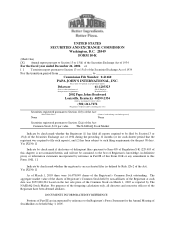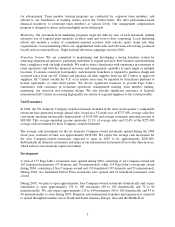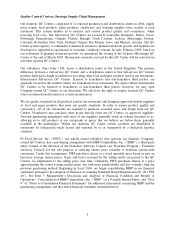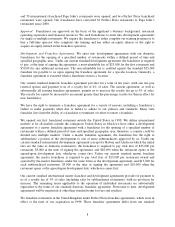Papa Johns 2004 Annual Report Download - page 11
Download and view the complete annual report
Please find page 11 of the 2004 Papa Johns annual report below. You can navigate through the pages in the report by either clicking on the pages listed below, or by using the keyword search tool below to find specific information within the annual report. 10
Ongoing supervision of training is monitored by the franchise training team. Multi-unit franchisees are
encouraged to appoint training store general managers or hire a full-time training coordinator certified to
deliver Company-approved programs in order to train new team members and management candidates for
their restaurants. Our area franchise directors maintain open communication with the franchise
community, relaying operating and marketing information and new ideas between franchisees and us.
Internationally, training is monitored by our international director of training as well as regional directors
and international business managers assigned to specific franchisee territories. We also maintain
communications with our franchisees through periodic system-wide meetings and newsletters.
Franchise Operations. All franchisees are required to operate their Papa John’s restaurants in compliance
with our policies, standards and specifications, including matters such as menu items, ingredients,
materials, supplies, services, fixtures, furnishings, decor and signs. Each franchisee has full discretion to
determine the prices to be charged to its customers.
Franchise Advisory Council. We have a Franchise Advisory Council that consists of Company and
franchisee representatives of domestically owned restaurants. The Advisory Council and subcommittees
hold regular meetings to discuss new marketing ideas, operations, growth and other relevant issues.
We currently communicate with, and receive input from, our franchisees in several forms, including
through the Company’s Franchise Advisory Council, annual operations conferences and various regional
meetings conducted with franchisees throughout the year and participation in an operators’ exchange best
practices forum in which numerous franchisees also participate. We are committed to communicating
with, and receiving input from, our franchisees regardless of the venue or form such communications
may ultimately take.
Reporting and Business Processes. We collect weekly and monthly sales and other operating information
from Papa John’s franchisees. We have agreements with substantially all Papa John’s domestic
franchisees permitting us to debit electronically the franchisees’ bank accounts for substantially all
payments to us including the payment of royalties, Marketing Fund contributions, risk management
services, and purchases from our Print and Promotions operations and QC Centers. This system
significantly reduces the resources needed to process receivables, improves cash flow and mitigates the
amount of past-due accounts related to these items. Franchisees generally are required to purchase and
install the Papa John’s PROFIT System in their restaurants (see Company Operations — Point of Sale
Technology).
Industry and Competition
The restaurant industry is intensely competitive with respect to price, service, location and food quality,
and there are many well-established competitors with substantially greater financial and other resources
than Papa John’s. Competitors include a large number of international, national and regional restaurant
chains, as well as local pizza operators. Some of our competitors have been in existence for a
substantially longer period than us and may be better established in the markets where our restaurants
are, or may be located. Based on independent third-party research, the United States Quick Service
Restaurant (“QSR”) Pizza category, which includes dine in, carry out and delivery, had sales of
approximately $33.0 billion in 2004, of which Papa John’s share was reported as 5.1%. Within the pizza
segment of the restaurant industry, we believe our primary competitors are the national pizza chains,
including Pizza Hut, Domino’s and Little Caesars, and several regional chains, including chains
executing a “take and bake” concept. A change in the pricing or other marketing strategies of one or more
of our competitors could have an adverse impact on our sales and earnings. Additionally, a continued
increased emphasis on carryout business by traditional casual dining restaurants, such as Applebee’s and
























